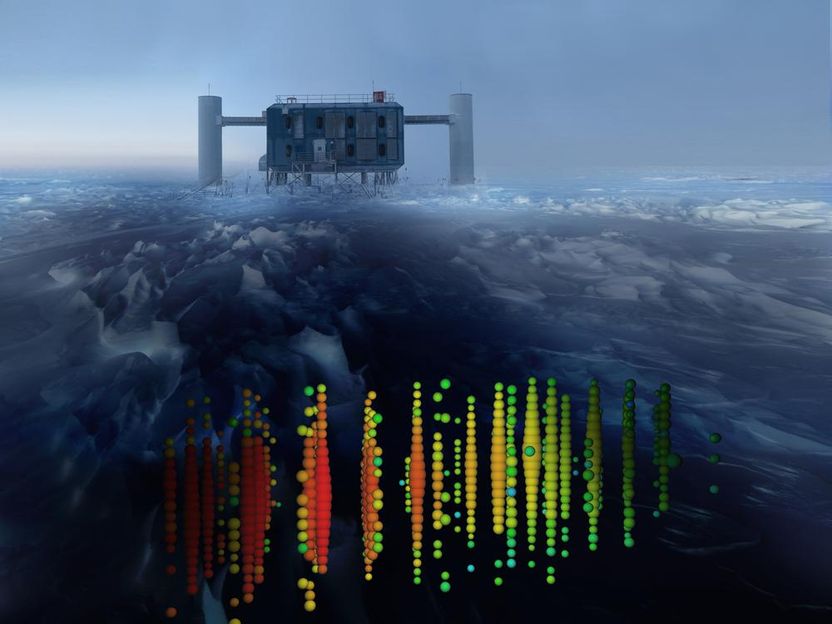IceCube spots more cosmic neutrinos – and analyses their characteristics
Antarctic observatory confirms origin of high-energy neutrinos beyond the solar syste
The South Pole observatory IceCube has detected further high-energy neutrinos from outer space and confirms that their origin lies beyond our solar system. This new analysis, published in the journal Physical Review Letters provides an independent validation of the first detection of those cosmic neutrinos from beyond our solar system, published two years ago. Another study, lead by DESY scientists, combines the new data with already existing data and reveals important properties of the astrophysical neutrino flux with never before achieved precision. This study was published in parallel in The Atsrophysical Journal.

The IceCube observatory near the Amundsen-Scott station at the South Pole.
The IceCube Collaboration
“Due to the combination of several independent data samples we reached a point where we can not only say “Great, we have seen neutrinos!” but are also capable of studying them with high precision. We can determine the energy spectrum and the neutrino type composition of the extraterrestrial neutrino flux,” explains DESY scientist Markus Ackermann, who was involved in the analysis. “This gives us hints concerning their origin and how they are created deep within the universe,” adds Lars Mohrmann, who has been working on the combination of the data sample as part of his PhD thesis. “For example we can already rule out that the neutrinos are created during neutron decay.”
Neutrinos are subatomic particles that travel throughout the universe almost undisturbed by matter. Their tracks are pointing directly to their sources. For high-energy neutrinos, those sources are expected to be the most extreme environments in the universe: black holes or massive exploding stars, that are able to accelerate subatomic particles to energies over a million times the energies achieved by record-breaking human-made accelerators, such as the LHC at CERN. These extremely energetic particles rain constantly on our planet and are called cosmic rays.
“Cosmic neutrinos are the key to yet unexplored parts of our universe and might be able to finally reveal the origins of the highest energy cosmic rays,” says IceCube collaboration spokesperson Olga Botner of Uppsala University. “The discovery of astrophysical neutrinos hints at the dawn of a new era in astronomy.”
Neutrinos are never directly observed, but IceCube is able to see the by-products of a neutrino interaction with the Antarctic ice. This cubic-kilometer detector records a hundred thousand neutrinos every year. Most of them are produced by the interaction of cosmic rays with the Earth’s atmosphere. Billions of so called atmospheric muons, which are created in the same interactions, also leave traces in IceCube. And from all of these traces, researchers are looking for only a few dozen astrophysical neutrinos, which will expand our current understanding of the universe.
The search presented now by the IceCube Collaboration uses an old strategy for a neutrino telescope: it looks at the universe through the Earth, using our planet to filter the large background of atmospheric muons. More than 35,000 neutrinos were found in data recorded between May 2010 and May 2012. At the highest energy, above 100 Teraelectronvolts (TeV), the measured neutrino rate cannot be explained by neutrinos produced in the Earth’s atmosphere, indicating the astrophysical nature of high-energy neutrinos. The analysis presented in this paper suggests that more than half of the 21 neutrinos above 100 TeV are of cosmic origin.
This independent observation shows good agreement with previous results by IceCube and confirms the high rate of astrophysical neutrinos. Even though scientists are still counting them by the handful, IceCube results are close to the theoretical maximum rates based on potential cosmic ray sources. The intensity of this neutrino flux shows that cosmic ray sources are also efficient generators of neutrinos. And, therefore, these tiny particles are further endorsed as the perfect tools to explore the extreme universe.
The observed high-energy neutrinos are a brand-new neutrino sample independent from the first results in 2013, which searched for high-energy neutrinos mostly in the southern sky. The current search looked for muon neutrinos only. These neutrinos produce a muon when they interact with the ice. This gives them a characteristic signature in IceCube, called a track, and makes them easy to identify. The same behaviour is expected for an atmospheric muon, but by looking only at the Northern Hemisphere, researchers know that a detected muon could have only been produced by a neutrino interaction.
These neutrino-induced tracks have a very good pointing resolution, in which they can locate their sources within less than a degree. However, IceCube’s studies have not yet found a significant number of neutrinos coming from any single source. The neutrino flux measured by IceCube in the Northern Hemisphere has the same intensity as the astrophysical flux in the Southern Hemisphere. This adds support to a large population of extragalactic sources, since otherwise sources in the Milky Way would dominate the flux around the galactic plane.
IceCube includes a total of 5160 photosensitive detectors, the so-called digital optical modules hanging from 86 steel cables which are deployed up to 2.5 kilometres deep in the ice and explore a whole cubic kilometre of Antarctic ice. They measure the weak flashes of light which are generated by the extremely rare collisions of neutrinos with the Antarctic ice. A surface array, so called IceTop, and a denser inner subdetector, so called DeepCore, significantly enhance the capabilities of the observatory, making it a multipurpose facility.
Original publication
"Evidence for Astrophysical Muon Neutrinos from the Northern Sky with IceCube"; M.?G. Aartsen et al. (IceCube Collaboration); "Physical Review Letters", 2015
"A combined maximum-likelihood analysis of the high-energy astrophysical neutrino flux measured with IceCube"; M. G. Aartsen et al. (IceCube Collaboration); „The Astrophysical Journal“, 2015




























































